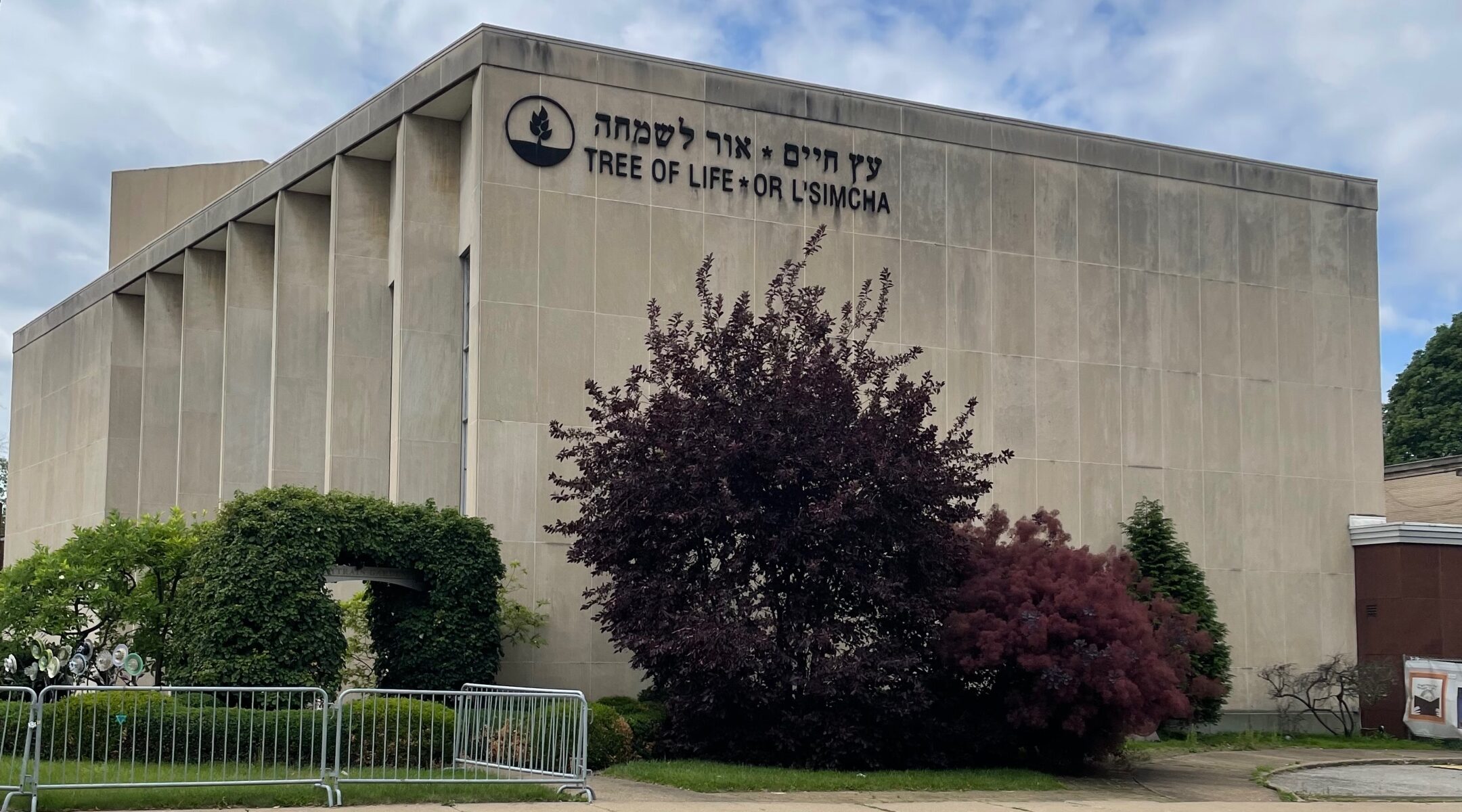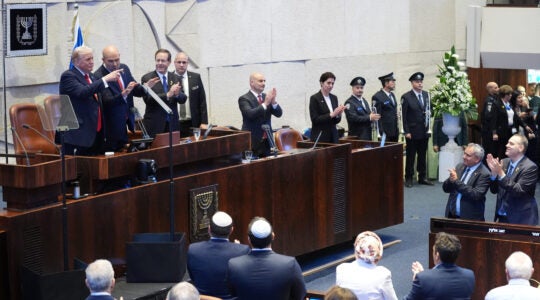PITTSBURGH (JTA) — As the gunman in the Pittsburgh synagogue shooting stood trial over the past several weeks, the defense made clear that they believed their client had committed the attack, and they declined to present evidence or call witnesses.
Now, after Robert Bowers was convicted on all 63 counts he faced, his lawyers are ready to mount a defense with one goal: to save him from the death penalty.
As in the previous stage of the trial, the testimony over the next few weeks promises to be searingly personal even as the lawyers debate obscure points of law.
But in this case, it’s not just the prosecution that is ready to tell an intimate story about a ruined life. The defense wants jurors to know about the events and disabilities they say shaped the defendant’s life before he killed 11 Jews at prayer on Oct. 27, 2018.
“What we are going to present in this phase of the case is to shine a greater light on how his distorted thinking came about,” said Michael Burt, one of the defendant’s lawyers, as the sentencing phase of the trial opened on Monday. “How did a man … with no criminal history, all of a sudden decide to pick up his weapons and shoot 11 victims.”
The prosecution has the opposite goal: setting out to prove aggravating factors that would incline the jury toward the death penalty. They elicited testimony from the families of eight victims who were elderly or infirm. Children of elderly parents and the sister of two men with mental disabilities grew emotional as they described the delicate and sometimes tense relationship caregivers have with vulnerable family members.
Echoing the Torah reading about welcoming guests that was scheduled for the day the gunman attacked the synagogue, Diane Rosenthal said her brother Cecil loved to talk endlessly to anyone he met.
“He was much more comfortable with friends and family but he always welcomed strangers,” she said. “He was always very excited to meet them and talk their ear off and continue talking as they walked away. He just could not keep quiet.” She wept for a moment.
Burt said the defense was ready to bring an array of medical experts to testify that his client’s brain was structurally incapable of dealing with the real world. He showed slides representing the anatomy of a human brain to demonstrate how experts will identify abnormalities in the gunman’s frontal and temporal lobes.
“The structure and function of Mr. Bowers’ brain is impaired in many respects,” Burt said. “The impediments caused him to form delusional and paranoid beliefs. Those delusional beliefs led directly to the horrible events of Oct. 27, 2018.”
The defense plans to outline the gunman’s history “of psychiatric institutionalization and multiple suicide attempts,” Burt said. He added, “Active psychosis makes it impossible to assess stimuli and read the world appropriately.”
Throughout opening arguments and Monday’s testimony, the defendant, clad in a gray sweater and a collared shirt, looked away from the witness stand, as he has for most of the trial thus far. He was often hunched over, writing.
Troy Rivetti, the U.S. attorney who opened the federal government’s arguments on Monday, said he expected the gunman’s lawyers to mount a mental health defense and that the government was ready to rebut it.
Rivetti said the government had already met the thresholds to prove that the defendant’s crimes were eligible for the death penalty earlier in the trial.
“All of that evidence carries over,” Rivetti said. “Our presentation of evidence in this phase, the eligibility phase, will be much shorter.” By that token, the government wrapped up its case by 2:30 p.m., after just five and a half hours. Judge Robert Colville adjourned until 10 a.m. Tuesday, when the defense will begin its case.
That does not mean the trial will end soon. There is a second portion of the sentencing phase, which could last for weeks, in which the government is expected to include victim impact statements and the defense is expected to introduce their client’s loved ones and delve into his upbringing.
Prosecutors have sought to keep the defense from making a number of arguments, including that the death penalty does not deter murder, or that the jury is not required to impose the death penalty. It’s not clear how Colville ruled on those submissions, but Burt frequently reminded the jury, without objection from the prosecution, that Colville was required to sentence the gunman to life without the possibility of parole if jurors decide that the death penalty is not merited.
Colville also granted a request by the defense to split the sentencing phase of the trial into two parts. The first determines whether the defendant is eligible for the death penalty based on the capital crimes he committed. The second determines whether there are mitigating factors that would lead a jury to decide against sentencing him to death.
Robin Maher, executive director of the Death Penalty Information Center, which tracks death penalty cases in the United States, told the Jewish Telegraphic Agency last week that the defense team would likely seek to show that their client does not meet the narrow standards the Supreme Court has set for the death penalty.
“Chiefly, the defense team will present evidence about Mr. Bowers’ life,” said Maher. “His life experiences, his social background and, very importantly, his mental health and his brain functioning. And that’s because the Supreme Court has said that we don’t give death sentences for all murders and we don’t give them to all murderers. We only give the death sentence to a subset of people, individuals that we find most deserving of a death sentence.”
Rivetti, the prosecutor, outlined the three factors the government must establish in order for the death penalty to apply in this case, as determined by the Supreme Court: Was the defendant over 18? (The gunman was 46 in 2018.) Did he act with a sufficient level of intent? Has the government proven at least one aggravating factor?
Rivetti reviewed some of the evidence from the preceding phase of the trial to argue that the gunman’s intent was more than proven. He referred to posts the defendant had written on Gab, a social media platform friendly to the far-right, propagating the theory that HIAS, the Jewish refugee aid group, was planning on bringing migrants to the United States to murder white people. HIAS had partnered with one of the congregations that the gunman attacked, Dor Hadash.
“You know so much more: His research and planning, his posts on Gab about HIAS,” Rivetti said. “He drove 30 minutes to Tree of Life, he made decision after decision. He came to kill and each decision he made shows intent.”
The defendant had programmed his computer to erase all of its memory 200 minutes after he had left his apartment, Rivetti said, mounting a slide of the computer screen forensic experts found when they reached his apartment. Its last line of code included the terms “200 minutes shred.” Nothing else was recoverable.
Rivetti repeated what the shooter told police after he was subdued: “All these Jews need to die.”
That prompted Burt, the defense attorney, to plead with the jurors to place everything the gunman said in its full context.
“Don’t consider a statement where he is saying something purposeful without considering the whole statement,” he said. “What they show of Mr. Bowers’ intent is irrational thinking.”
Rivetti said the government could prove four statutory aggravating factors that favor the death penalty, although just one was needed. It had already proven two other requirements, he said: that the defendant had premeditation and that he killed multiple people. On Monday, the government offered additional testimony to prove another two: that the shooter posed a grave risk of death to additional people, and that the victims were vulnerable.
The government brought in witnesses who were law enforcement officers and testified as to the risks the massive shooting spree posed to the first responders and others in the synagogue.
In order to prove the other aggravating factor, the vulnerability of the victims, Rivetti began his case with a photo of a cane propped up against a pew: It belonged to Bernice Simon, 84, who was shot as she sought to stanch the blood on her husband Sylvan’s back using her prayer shawl.
“She had her cane right beside her when the defendant murdered her,” Rivetti said.
He named the victims who were over 70, qualifying as elderly under the law: Daniel Stein 71, Joyce Fienberg, 75, Bernice Simon, 84, Sylvan Simon, 86, Melvin Wax, 87, and Rose Mallinger, 97. He also named brothers Cecil and David Rosenthal, who had mental disabilities. (The other victims were Richard Gottfried, Jerry Rabinowitz and Irving Younger.)
The family members who testified to the victims’ infirmities grew emotional as they described the delicate dance of dealing with family who did not want to acknowledge that they needed the assistance their loved ones offered. Michelle Weis recalled how the back pains and diminished vision that her 86-year-old father Sylvan Simon suffered from didn’t stop him from being active. “He wanted to do what he wanted to do. He wanted to be young,” she said.
This spirit came to bear, when he wanted to get a new dog, but Weis wouldn’t let him, she said, “Because how is he going to take care of his dog when he can’t take care of himself?”
Stanley Mallinger lived with his mother, Rose, to care for her. Mallinger, 97, was shot while attending services with her daughter, Andrea Wedner, who was wounded. He described how his mother would go to the basement even though it was forbidden territory for her after she had a number of falls.
“I caught her a couple of times going down there,” he said, laughing. “Things were moved around.”
She was willful but sometimes her infirmities led her to depression, he said. That’s when Andrea would come in. “My sister Andrea would always talk her down,” he said.
JTA has documented Jewish history in real-time for over a century. Keep our journalism strong by joining us in supporting independent, award-winning reporting.






